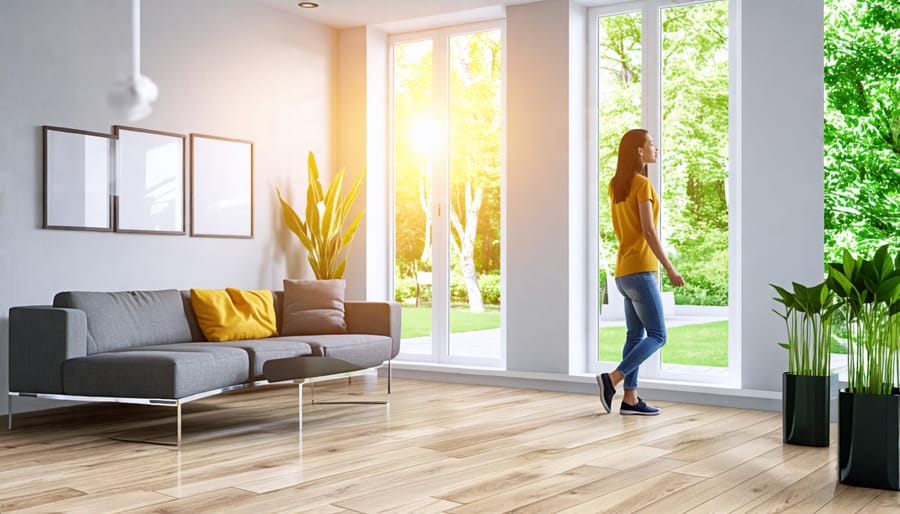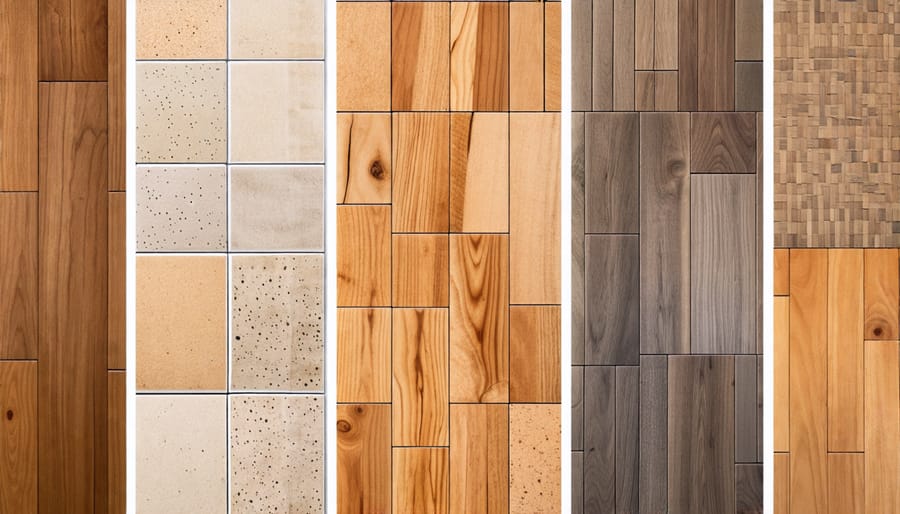Choose zero VOC flooring to protect your indoor air quality and family’s health. Volatile organic compounds (VOCs) are harmful chemicals that off-gas from many traditional flooring materials, potentially causing respiratory issues, headaches, and other health problems. Fortunately, non-toxic options like solid hardwood, natural linoleum, cork, and certain engineered woods and laminates are available. When selecting zero VOC floors, look for reputable certifications like FloorScore, GreenGuard Gold, or GreenLabel Plus to ensure the product meets strict emissions standards. With careful material choice and proper installation, you can enjoy beautiful, durable floors while keeping your home environment safe and healthy.
What are VOCs and Why Avoid Them?
Common VOC Sources in Flooring
Many traditional flooring materials can off-gas VOCs into your home’s air. Carpeting is a major culprit, as it often contains synthetic fibers treated with chemicals, adhesives, and padding that emit VOCs. Vinyl flooring, especially older varieties, can release VOCs from plasticizers and stabilizers. Laminate floors may contain formaldehyde in their core boards and adhesives. Even seemingly natural options like engineered hardwood can have VOC-containing finishes, glues, and core materials. When selecting flooring, be cautious of these common sources and opt for products specifically labeled as low or zero VOC to ensure healthier indoor air quality. Look for third-party certifications like GreenGuard or FloorScore that verify a product’s low-emission status. By making informed choices, you can significantly reduce the VOC levels in your home and create a safer, more comfortable living environment for your family.

Health Risks of VOC Exposure
Exposure to VOCs can lead to various short-term health issues, such as eye, nose, and throat irritation, headaches, nausea, and dizziness. These symptoms may be more severe for individuals with allergies, asthma, or chemical sensitivities. Prolonged VOC exposure has been linked to more serious long-term health effects, including liver and kidney damage, central nervous system disorders, and an increased risk of certain cancers. Additionally, VOCs can contribute to the formation of ground-level ozone and smog, exacerbating respiratory problems. While the severity of health risks depends on factors like the type and concentration of VOCs, exposure duration, and individual sensitivity, opting for zero VOC flooring can significantly minimize these potential hazards and create a healthier indoor environment for you and your family.
Benefits of Zero VOC Flooring

Improved Indoor Air Quality
Traditional flooring materials can emit volatile organic compounds (VOCs) that compromise indoor air quality and potentially harm your health. These airborne chemicals may cause headaches, dizziness, respiratory issues, and even long-term effects like organ damage. Zero VOC flooring is engineered to eliminate these harmful emissions, ensuring a safer living environment for you and your loved ones. By choosing non-toxic, zero VOC options such as natural hardwood, cork, bamboo, or certified low-emission laminate and vinyl, you can significantly reduce indoor air pollution and create a healthier home. Improved indoor air quality not only enhances your overall well-being but also benefits those with allergies, asthma, or chemical sensitivities. Invest in zero VOC flooring to breathe easier and enjoy a cleaner, more comfortable living space.
Eco-Friendly and Sustainable
Choosing zero VOC flooring is an eco-friendly decision that supports sustainability and reduces your home’s environmental impact. These flooring materials are made without harsh chemicals, minimizing air pollution and the release of harmful substances into the atmosphere during production. Many zero VOC options, such as bamboo, cork, and linoleum, come from renewable resources and are biodegradable, further contributing to their green profile. By installing zero VOC floors, you not only create a healthier living space for your family but also promote more responsible manufacturing practices and a cleaner planet. Opting for these sustainable materials is a simple yet impactful way to reduce your carbon footprint and make your home more environmentally friendly.

Types of Zero VOC Flooring
Hardwood
For a natural and sustainable option, consider zero VOC hardwood flooring. Solid hardwood floors are inherently VOC-free since they are made from a single piece of wood without adhesives. If opting for engineered hardwood, look for brands that use water-based, low-VOC adhesives and finishes. When installing hardwood floors, choose zero VOC underlayments and adhesives. To maintain the beauty and durability of your floors while keeping your home’s air clean, use VOC-free hardwood cleaners and polishes. Pair your eco-friendly flooring with eco-friendly furniture for a cohesive, non-toxic living space that promotes well-being.
Bamboo
Bamboo flooring is an excellent choice for eco-conscious homeowners seeking zero VOC options. As a rapidly renewable resource, bamboo is highly sustainable and environmentally friendly. When selecting bamboo flooring, look for products that are certified as low-emitting or zero VOC, ensuring they meet strict indoor air quality standards. Bamboo is also known for its durability, making it a long-lasting flooring solution for high-traffic areas. With a variety of colors and styles available, from natural to carbonized, bamboo flooring can complement any home décor while providing a healthy, non-toxic living environment for you and your family.
Cork
Cork flooring is an excellent zero VOC option that’s both stylish and sustainable. Made from the bark of cork oak trees, this natural material is harvested without harming the tree, making it an eco-friendly choice. Cork contains suberin, a waxy substance that gives it inherent resistance to mold, mildew, and pests without the need for toxic treatments. Its soft, cushiony texture provides comfort underfoot and reduces noise, while its insulating properties help regulate room temperature. Cork flooring is also hypoallergenic, repels dust, and is easy to maintain with regular sweeping and damp mopping, making it a healthy choice for any home.
Tile and Stone
Tile and stone are excellent zero VOC flooring choices that add natural beauty and durability to your home. Look for options like ceramic, porcelain, glass, and natural stone such as marble, granite, or slate. These materials are inherently non-toxic and do not emit harmful chemicals. When installing tile or stone, choose low-VOC or zero VOC adhesives, grouts, and sealants to ensure a completely non-toxic installation. Proper sealing of porous materials like natural stone can help prevent the absorption of potentially harmful substances. With their timeless appeal and VOC-free properties, tile and stone are a smart choice for a healthy, stylish home.
Installation and Maintenance Tips
Proper Installation Techniques
When installing zero VOC flooring, proper techniques are crucial for a successful, long-lasting result. Begin by thoroughly cleaning and leveling the subfloor to ensure a smooth, even surface for installation. If using adhesive, choose a non-toxic, zero VOC variety specifically designed for your flooring type. Follow the manufacturer’s instructions for acclimating the flooring materials to your home’s temperature and humidity levels before installation. This helps prevent warping or gaps due to expansion and contraction. During installation, take care to maintain consistent spacing between planks or tiles, using spacers if necessary. Seal any seams or edges with a non-toxic, zero VOC sealant to protect against moisture and enhance durability. By following these expert tips and taking your time, you’ll achieve a beautiful, healthy, and eco-friendly floor you can enjoy for years to come.
Maintenance and Cleaning
To keep your zero VOC floors in top condition, regular maintenance is key. Sweep or vacuum daily to remove dirt and debris that can scratch the surface. For a deeper clean, use a damp mop with a mild, non-toxic cleaner specifically designed for your flooring type. Avoid harsh chemicals or abrasive scrubbers that can damage the finish. For tough stains, spot clean with a soft cloth and the appropriate cleaner. Prevent excess moisture by wiping up spills immediately and avoiding wet mopping. Place doormats at entrances to catch dirt and grit, and consider using felt pads on furniture legs to prevent scratches. With consistent care and gentle cleaning methods, your zero VOC floors will remain beautiful and healthy for years to come.
Conclusion
Choosing zero VOC flooring is a smart decision for creating a healthier home environment. By eliminating toxic chemicals and off-gassing, you can significantly improve your indoor air quality and reduce the risk of respiratory issues, headaches, and other health problems associated with VOC exposure. Zero VOC floors not only contribute to a safer living space but also demonstrate your commitment to sustainability and eco-friendly practices. With a wide range of stylish and durable options available, from natural hardwood to luxury vinyl planks, you can easily find a zero VOC flooring solution that complements your home’s décor while promoting the well-being of your family and guests. Investing in zero VOC flooring is a simple yet powerful way to create a cleaner, greener, and more inviting home that you can feel good about for years to come.
